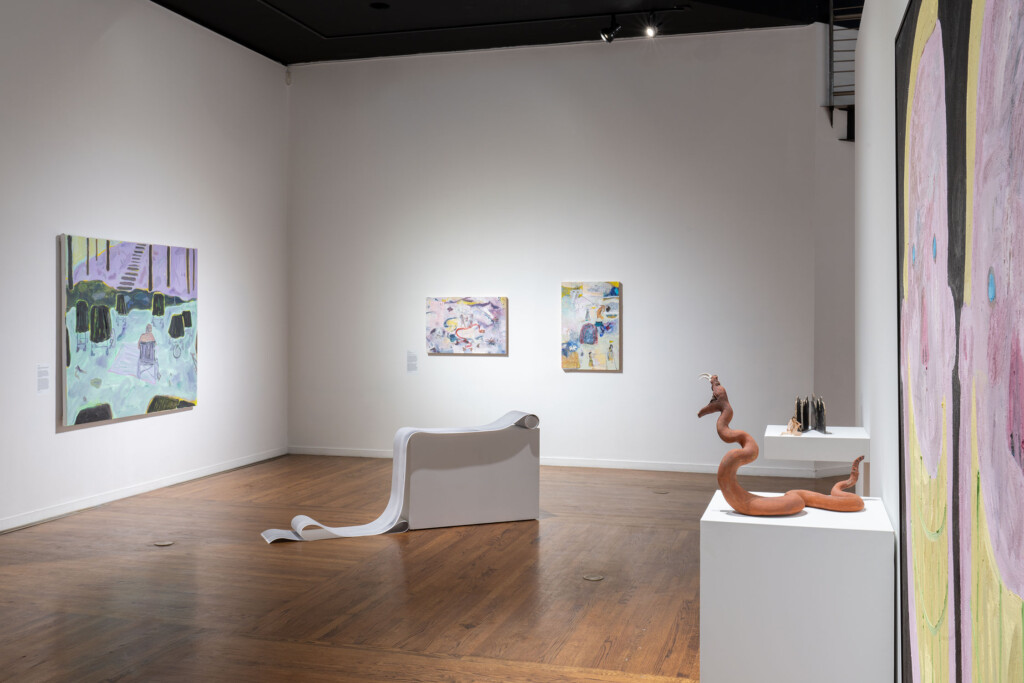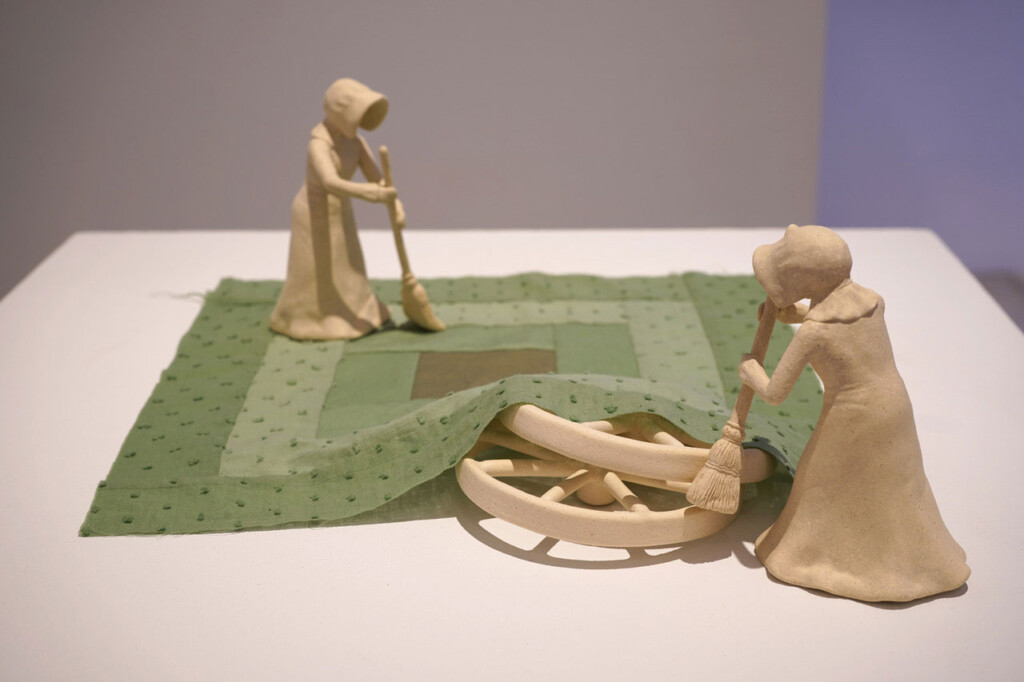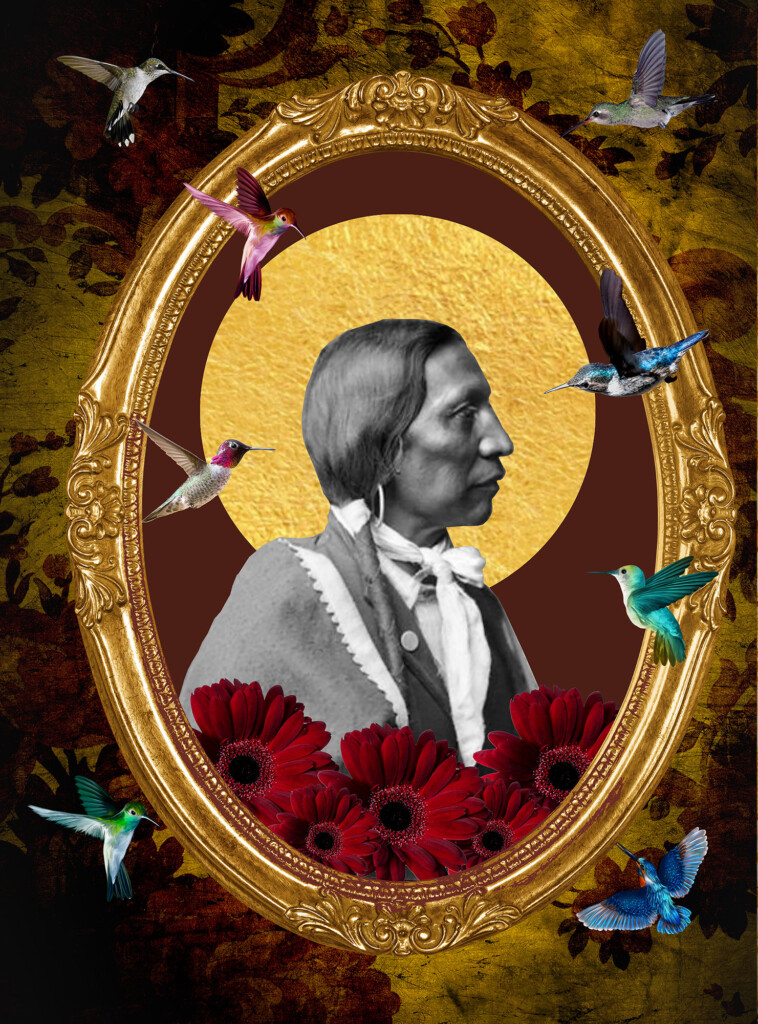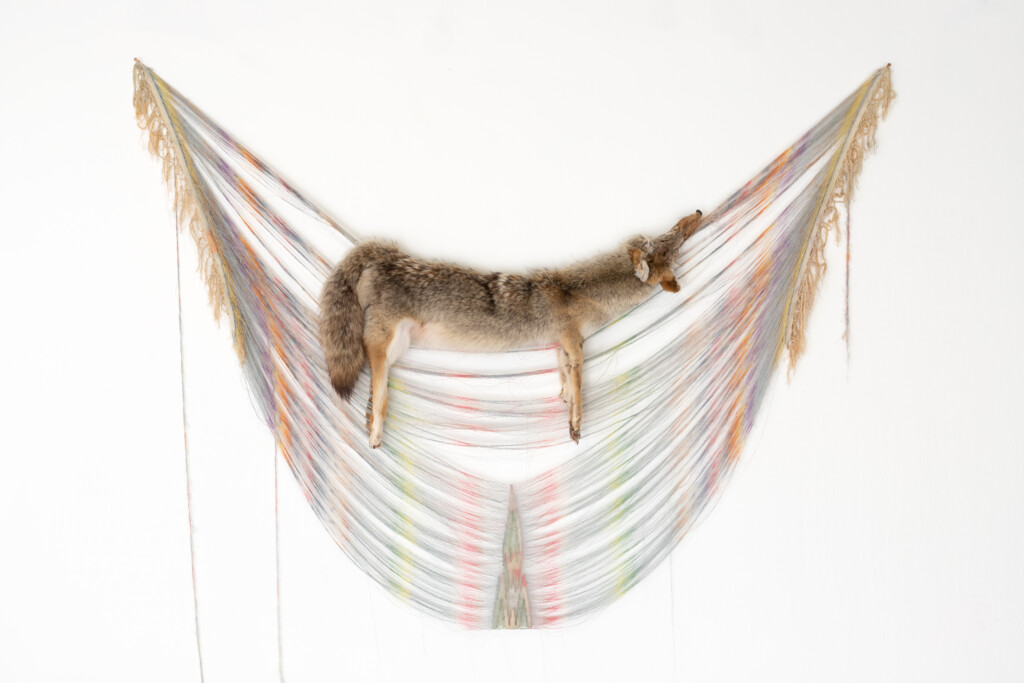Five current shows at the Utah Museum of Contemporary Art (UMOCA) cumulatively paint an impressive portrait of the breadth and depth of contemporary works by Utah artists. The Utah Review summarizes the quintet of exhibitions in this roundup.
A Greater Utah
To those outside of Utah and, frankly, to many in the Beehive State, perceptions about the state’s cultural geography tend toward the monolith or defer to Salt Lake City and the more heavily populated areas of northern Utah as the most influential. But, in fact, the six regions depicted in UMOCA’s exceptional, elucidating A Greater Utah exhibition emphasize the enlightened awareness of a cultural foundation as remarkably diverse, spectacular and durable as the state’s natural landscapes.
The state’s efforts to promote tourism have succeeded at showcasing breathtaking natural wonders but they can be used as well to magnify just how surprising and refreshing is the cultural choir in Utah, which is composed of many expressive and visual art forms. As Jared Steffensen, UMOCA curator, explains, “The exhibition provides a site for oft-overlooked geographic and artistic centers, expands narratives and definitions of the local and cultivates a chorus of Utah voices and perspectives.”
Viewers can easily identify each of the six regions represented, even without the benefit of labels and signage. The artists which each regional curator selected to represent the region skillfully encapsulate the distinctive dynamics of each area’s culture, as informed and influenced by its history, topography, demographics, politics and spiritual bearings.
Serving as curator for northern Utah, Tiana Birrell took note of numerous juxtapositions, explaining how some of the state’s most densely populated areas exist next to the west desert and Great Salt Lake.
Regarding the five artists represented (Levi Jackson, Amanda Lee, Art Morrill, Mitsu Salmon and Fazilat Soukhakian), Birrell explained how a migratory map and airline flight pattern, along with a “repetitive scribble up and down the I-15,” could chart where each of them live and create. “Like the millions of birds that migrate and pass through the Great Salt Lake,” Birrell notes, “these five artists represent what it means to travel, both physically and metaphorically, across perceived boundaries and to navigate complex histories and landscapes.” For example, Lee’s Wayfinding (2019), screen print and graphite, documents an eight-mile hike through newly deposited lava fields. As a test of the artist’s capacity to intuit from formal and traditional knowledge foundations, Lee noted that an individual ahead of her placed small white coral pieces as markers in the ebon landscape to guide her way. Salmon uses ikebana, the Japanese form of floral arrangements, to highlight the use of Asian laborers for building the Transcontinental Railroad and her grandmother who worked at a laundromat. Soukhakian, a native of Iran, has several selections from two photographic projects, Queer in Utah and Defiance, reflecting rebellion against the cultural status quo that has been influenced by Utah historical roots in Mormonism.

The triptych of large photographic prints for Levi Jackson’s Midnight Swim (after Shiras) is striking and breathtaking. Emulating the 19th century wildlife photographer George Shiras, Jackson captures nighttime images of a mountain stream during a runoff, as last winter’s record snowpack was melting.
Surrealism and abstract art subjects generated in various multimedia forms highlight the Salt Lake County region, as curated by Nancy Rivera. The artistic statements are among the most sharply articulated surrounding the sociopolitical issues surrounding Utah’s largest metropolitan area (perhaps even more so in the southern Utah section of the exhibition). They range from the rising costs of living and working in a region marked by traffic congestion and a changing downtown skyline to a growing gap in availability of affordable housing, along with concerns about how a increasingly dense human presence is straining the area’s natural and water resources.
Of the artists (Stephanie Espinoza, Vanessa Romo, Wren Ross, and Xi Zhang), Rivera notes, “Each of the artist’s creations stem from individual circumstances, yet they collectively demonstrate how sharing our experiences propels us into similar states of mind and weaves a sense of our shared humanity together.” A fine interplay of surrealism and expressionism, Ross’ An Emanation, a 2020 watercolor with colored pencil, ink and casein, is a compelling visual choreographic statement of how catharsis might be manifested in our inner psychological and cognitive realms.
Meanwhile, central Utah, highlighted by Sanpete Valley, contains among the most durable vestiges of early Mormon pioneer settlements. Amy Jorgensen selected seven artists to “reexamine traditional narratives,” for developing a more comprehensive portrait of the Sanpete Valley area and to question the prevailing myths and folklore associated with the region.

A three-minute video piece, Kelly Brooks’ Central Walk Through has an ASMR effect, with how it might feel like to walk through the area, not unlike those who migrated and settled there. Richard Gate’s mixed-media collage painting, Star Map, Cassiopeia, rendered in oil, paper, and xerox transfer on birch veneer panel, is a multifaceted autobiographical contemplation of his experiences in moving through spaces in the state’s central region. From Ray Farmer’s Baby Quilt series, two works, made with unglazed stoneware, fabric, thread and yarn, is the artist’s response to visiting the Salt Lake Daughters of Utah Pioneers Museum. Along with other pieces representing central Utah, Farmer’s work sparks thoughts about how we visualize stories and legacies handed down through generations and how they morph with knowledge and enlightenment, especially when we try to sweep the unflattering, problematic moments from our historical memory.
Brooks also collaborated with writer English Brooks to create a multimedia piece — a cellphone video and crayon prints — that takes rubbed impressions of fragments of poetic verse from various monuments commemorating Mormon pioneer settlements and subverts their original context.

One of the exhibition’s most impressive works is a video piece, just shy of three minutes, documenting a now-closed small independent store in Sterling, Utah: Thomas Grocery, which was owned by Lily Thomas. She worked into her nineties and served customers for more than seven decades. The store continued to operate, even after a Wal-Mart location opened in nearby Ephraim. A 2007 Deseret News feature quoted Thomas about how the superstore affected her business, where she once sold farm produce and items such as Western clothing and accessories. “There’s no way a little independent store can compete in prices with such a place as Wal-Mart,” she said, explaining why she started selling more soda pop and installed a hot dog machine. “So that’s changed everything a lot.” Thomas died shortly after the feature was published, at the age of 93.
Reza Savafi’s tribute to Thomas Grocery is a scrupulously detailed depiction of the historic site. He took hundreds of images of the building from every vantage point and used 3-D scanning technology and 360-degree video to create the video art. He added an abundant landscape from a virtual reality gaming source to make it seem that the store had just popped up in the middle of the landscape.

The same thematic impetus is carried through the work of Katie Hargrave and Meredith Laura Lynn in their documentation of the human footprints of tourism in the Arches National Park. In addition to a video projection, the artists stitched a tent with public domain images of tourists seen at the park.
The most prominent representation of Indigenous and Native American artists is found in the eastern Utah region, which is curated by Valentina Sireech. Joining Sireech are artists R.J. Colorow and Chelsea Kaiah.
As Sireech notes, the art represents creators who are committed to sharpening awareness of productive social activism, as they are “focused on cultural-centered issues of land and environment.” Some of the exhibition’s most intricately detailed works are found in this section. Artists variously use digital mixed media, photography, beads with customary materials and techniques, watercolor and ink drawings rendered in abstract form.

printed on archival matte-rag photo paper.
There are outstanding examples of artists using traditional media forms to emphasize their prominence in historical documentation, such as Colorow’s stunning watercolor-and-ink work titled Elk Women. Kaiah’s Connect, created with seed beads, coral, vintage beads, mother of pearl, dyed lamb leather, rope and cloth, is a vivid example of how traditional arts become a potent vehicle of communicating cultural stories and bringing forward individual identities who otherwise have been neglected, when considering community input about reclaiming the integrity of land and nature.
Representing Utah County, curator Peter Everett followed a different path by asking four artists to create work specifically for A Greater Utah. “There is a focus on material process and transformation whether it be through craft traditions, the layering of paint, or the repurposing of tools of industry,” Everett explained in the curator’s statement.

The four artists – Makia Sharp, Brooklynn Johnson, Rachel Stallings-Thomander and Collin Bradford – distinguished themselves by how they experimented with techniques and substances in work that encourages viewers to interpret them as liberally as possible and relevant to their own experiences, without feeling a need for the artist to explain them. The gorgeous pastels of Johnson’s Pear Tree Tie, an oil on linen painting, is a quintessential example of this. It is joined by three other works by the artist (Peeling, Night of the Abalone and Grief Blanket), all suggesting a creative process similar to combing beaches for fragments or objects that are forever separated from their holistic place and where we can learn to accept the inevitability of loss.
In southern Utah, a region that is being transformed by development and a growing population nearly, if not even faster, than in the state’s northern region, curator Jessica Kinsey selected artists who make the compelling argument. Kinsey states tersely, “That is exactly what is happening in Southern Utah–we are killing and erasing the thing we love.”
Photographic artist James Culbertson’s Crowds at Angels Landing (2019) documents the significant surge in tourism at Zion National Park, where visitors wait to undertake the five-and-a-half-mile hike. Other images are Visitor Center, Fawn, Shuttle and Angels Landing Trail.
Touching on a familiar sentiment about how humans view coyote as a dangerous predator, Kelly Tapìa-Chuning expands upon how humans view native species as competitive threats — for instance, those who hunt deer. One of four pieces, Sepultado, Este coyote ya No Ladra (Laid to Rest, This Coyote No Longer Barks) is an exceptional composition of the concept of double consciousness — a dismantled serape (Mexican blanket) and an unclaimed coyote hide from Utah, connected with copper nails.

Providing one of the exhibition’s strongest pieces in how the theme is articulated, Being Diné, Alana Tapaha explores a different threat of erasure: the potential loss of Diné Bizaad, a Navajo language. Tapaha approaches this from a precise representation that drives the theme home with blazing clarity. The work comprises layers of two types of paper. The words of her language are printed in small regular typeface on water-soluble paper, which dissolves when it comes into contact with water, while the English language translations are printed in bold typeface on the underlying sheet. The language had its written form created by the Navajo Code Talkers during the Second World War.
Kinsey further drives the erasure theme with a work.by nicolas b. jacobsen, a seventh-generation Utah-Mormon, raised on Nuwu homelands who identifies as trans-nonbinary. Their mixed media piece Pioneering Terra Nulliparous looks like a miniature toy layout, with action figures and elements taken from Mormon history. But, the multiple references to historical times in the objects they have chosen to include telegraph the holistic outcomes of a pioneer history of colonization, occupation and development that regrettably might not stop until every remnant of the land’s previous eras is eradicated.

Left Time by Steven Stallings-Cárdenas
A superb video art piece, Left Time by Steven Stallings-Cárdenas is a smart riff on the ceaseless drumbeat as a metaphor of our monotonous existence in and out of our workday. Dressed in black pants, white shirt and black tie, the drummer plays a repetitive rhythmic phrase on his kit. In the short film, that phrase is omnipresent, as if the drummer can never fully liberate himself from the drudgery of the workday, whether or not he is driving, riding an elevator, being in a factory or lounging on a bed in a hotel room. Eventually, the drummer is found along the rim of the Grand Canyon, culminating in an improvised, more interesting rhythmic language. The rhythms swell and ebb with scrupulous control of cadences, as the filmmaker syncs up the percussive music perfectly with the images on screen.

A graduate of Brigham Young University, Stallings-Cárdenas is now pursuing his master of fine arts degree at Columbia University, working on a documentary about how artists who are or who’ve been affiliated with The Church of Jesus Christ of Latter-Day Saints identify themselves (for example, Mormon or ex-LDS artist).
Cake Stand Altar by Alyce Carrier
Alyce Carrier’s exhibition Cake Stand Altar arose from the artist’s journey to make sense about her sister’s disappearance, which occurred a few years ago. The sister returned after less than a year away from home but for Carrier, the question of why it occurred has remained. Thus, she has been processing the memories of what she considers a still implausible event.
Carrier plays the theme elegantly, with the clay ceramic pieces as models of uncontaminated, pristine memories. The emotional tensions of trying to comprehend her sister’s temporary disappearance are communicated through the sculpted pieces. Carrier is meticulous about the fine balance of roughness and smoothness in their appearance. The works appear strong and resilient but one also can appreciate their fragility, which could crack and shatter without warning.
This is the essence of art’s therapeutic potential, articulated realistically and intelligently. We often think how cracks might diminish or reduce the value of a piece. While there are no cracks in Carrier’s pieces, we intuit properly that any cracks or imperfections might reflect upon our own tensions and vulnerabilities, as we try to make sense out of events in our lives that likely will never be fully comprehensible.
Carrier communicates effectively how palliative our memories can be. The artist has printed copies of photos from her sister’s ninth birthday celebration. Patrons are invited to tear off a copy for themselves. The memories of happier times are easily discernible, but they also have been colored and seem not as sharp or as stark as the ceramic pieces Carrier created. It is a testament to persevering the objective of preservation.
Gut Set by Ben Sang
To appreciate Ben Sang’s Gut Set as a relevant theoretical companion piece to UMOCA’s main A Greater Utah exhibition, it is worthwhile to consider the artist-anthropologist’s appreciation of Baudrillard’s concepts of hyperreality and the simulacra.
Sang’s work comprises artifacts not collected for constructing a collage but rather as part of a more intellectually driven process of splicing and filtering them. He processes this until he finds the right context point that can carry its own weight as illustrating and demonstrating the tensions between and among the chosen objects.
As Baudrillard’s simulacra exemplifies how artifact copies or representations can emerge as their own realities, exclusive of the provenance of the objects, history or events they represent, Sang achieves a similar outcome in gathering objects, copies, representations, etc., that symbolically define Utah. Sang’s show in the museum’s Artist-In-Residence (AIR) Space opens up the vista more than what has been seen in previous shows in that gallery. He uses the artifacts to compact down the visual plane, which, in turn, produces that Baudrillard’s sensation where it no longer seems necessary to distinguish the boundary separating what seems real and what is being simulated.
For example, he shrinks down and multiplies the Tree of Life sculpture by Karl Momen. Other artifacts include a model of a detector scientific technicians used in the state’s west desert to detect high-energy particulars and cosmic rays. There is a drawing of the White Pocket in Vermilion Cliffs National Monument, where Sang places a digital image of a zombie bison on top of the unique white topped wave rock.
Statewide Annual UT ‘23: Mixed Media and Works on Paper
A serendipitous complement to the current aforementioned UMOCA exhibitions is the Statewide Annual UT ‘23: Mixed Media and Works on Paper, coordinated by The Utah Division of Arts and Museums (UA&M).
With two jurors from out of state (Julio César Morales from Arizona and Pat Hickman from New York), the UA&M, with guest curator Peter Hay, selected 28 works by 24 artists. It is worthwhile to head to the main gallery on the lower level to take in A Greater Utah first and then head upstairs to view the works in the Statewide Annual show. Following that sequence will reinforce the thematic pulse of A Greater Utah’s evidence of the broadly diverse range of cultural geography in the visual arts.
Among the prizes awarded were:
Best of Show ($1,000): Linear, Jean Richardson
Juror’s Award ($600): Two Turtles at Gikal, Brandi Chase
Juror’s Award ($600): Nepantla, Rocio Cisneros-Vasquez
Juror’s Award ($600): Obsessive Love Disorder, Jamie Clyde
Juror’s Award ($600): Skeletons in the Lake, Jim Frazer
Juror’s Award ($600): Void, Lenka Konopasek
Juror’s Award ($600): Last Tasmanian Tiger, Alison Neville
Honorable Mention ($200): Binding Death, James Rees
Honorable Mention ($200): Light in Her Countenance, Evelyn Roundy
A People’s Choice Award will be announced in early September and gallery visitors can vote until Sept. 1.

Some 394 works were submitted for consideration. Hickman, a nationally known full-time studio artist who,lives the Lower Hudson Valley, said the experience as a juror “has helped me understand and learn what is on the minds and hearts of the artists who submitted work. There are shared themes—loss, identity, mortality, fragility, climate concerns, and love of place.”
Morales, executive director and co-chief curator at MOCA Tucson. added, “Navigating boundaries between space, form, and material, the works invite the viewer to reflect on human relationships and the complexity of social structures.” Citing the show’s broader expressions of hope for an improved future, he explained, “One interesting throughline is how artists transform materials and push the boundaries of any given medium. Whether working with foliage or acrylic paint, these artists understand the necessity to alter their mediums in order to advance the conversation.”
For more information about the five exhibitions, see the UMOCA website.







